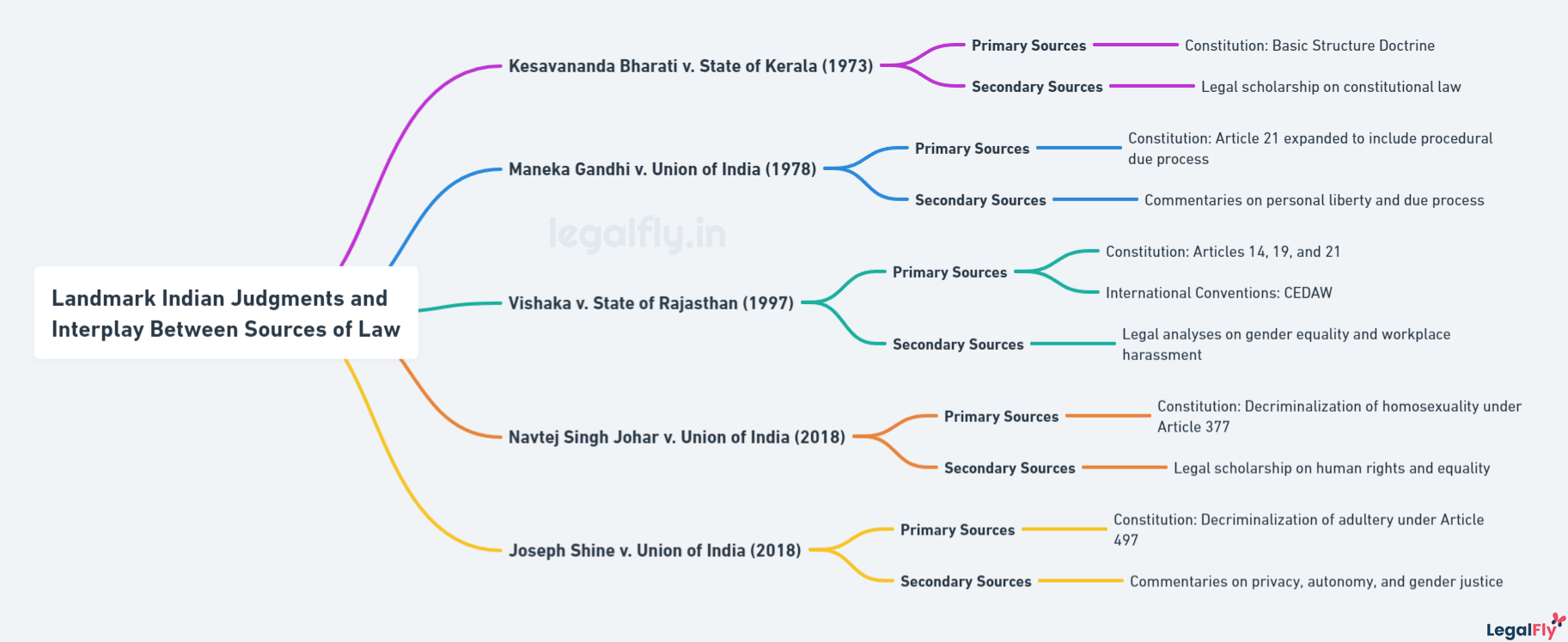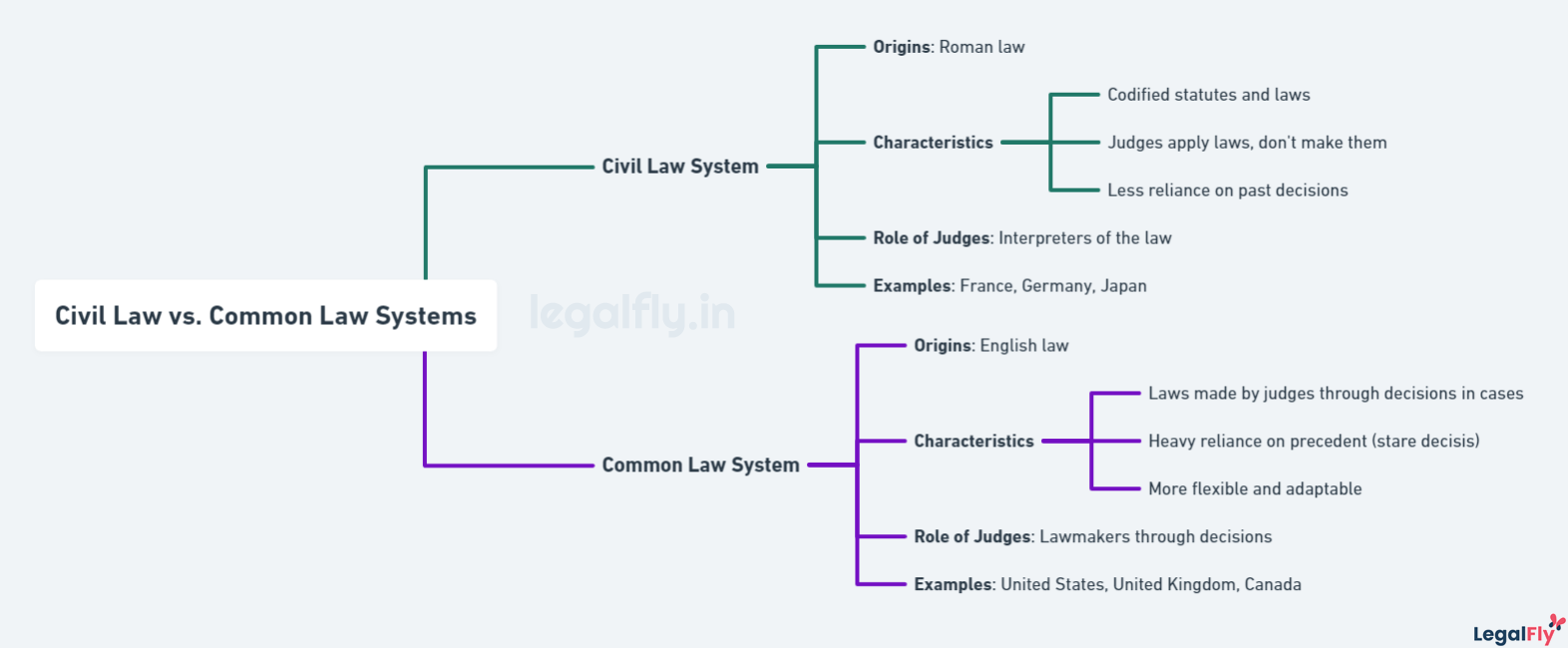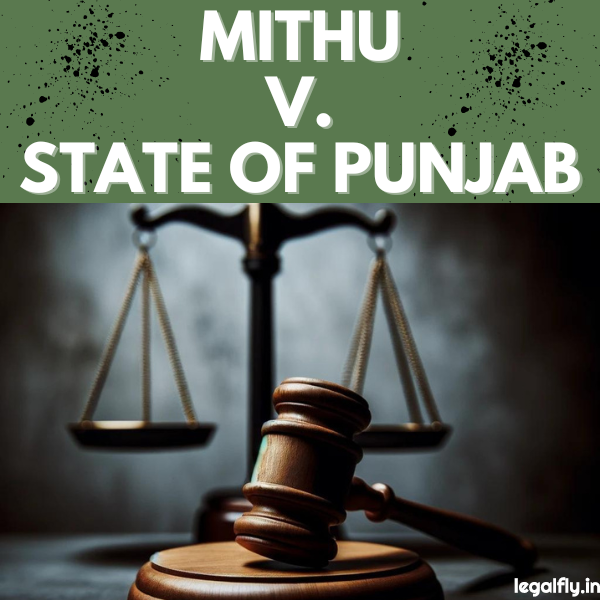Table of Contents
Introduction to the Sources of Law in Jurisprudence
The sources of law refer to the origins from which legal rules, principles, and norms are derived in a legal system. They provide binding rules that enable a state to govern its territory and regulate the behaviour of individuals and organizations within its jurisdiction. Identifying and applying appropriate sources of law is a fundamental aspect of jurisprudence across all legal systems.
The sources of law in Jurisprudence have evolved over the centuries, from ancient customs and religious codes to modern legislation and international treaties. Their importance lies in their ability to confer legitimacy and authority on the law. Reliance on recognized sources of law allows for consistency, stability, and predictability in the legal system.
There are three primary classifications of sources of law in Jurisprudence:

- Primary Sources: These include constitutions, legislation, judicial precedents, and customs. Primary sources establish binding laws and articulate general principles that must be applied in relevant cases. They are the foremost authoritative origins from which legal rules derive their validity.
- Secondary Sources: These consist of legal scholarship, commentaries, and analyses that explain, interpret, and develop the understanding of primary sources of law without binding themselves. Secondary sources provide guidance but do not constitute a source of law independently.
- Tertiary Sources: These are finding tools like legal dictionaries, encyclopedias, and research guides that facilitate researching and locating primary and secondary sources of law. They serve as reference materials rather than authoritative sources.
Primary Sources of Law
Primary sources of law in Jurisprudence are authoritative and binding legal sources that establish the law. The three branches of government (the legislative, the executive and the judiciary) create them and form the foundations of a country’s legal system. The most important primary sources of law are constitutions, legislation, judicial precedents, and customs.
Constitutions: The Foundation of Legal Systems
A constitution is a country’s supreme law and the source for all other laws. It establishes the structure of government and the relationship between the state and citizens. It outlines fundamental rights, directives of state policy, and the powers of each branch of government. A single branch of government cannot unilaterally change constitutions and often requires special amendment procedures.
Legislation: Statutes and Acts
Legislation refers to the laws enacted by a country’s legislature or Parliament. These take the form of statutes, acts, codes, and ordinances. Legislation covers various subjects, from crime to education to healthcare. The legislature has the power to make new laws, amend existing laws, and repeal obsolete laws through the lawmaking process. Statutes and acts passed by the legislature represent the majority of the laws that govern a society.
Judicial Precedents: Case Law as a Source
Judicial precedents refer to the body of case law produced by courts through written decisions on legal disputes. These form binding legal precedents under the doctrine of stare decisis (let the decision stand). Lower courts are obliged to follow precedents set by superior courts in the judicial hierarchy when deciding similar cases. The reasoning and principles of landmark judgments become part of case law and an authoritative primary source.
Customs: Traditional Laws and Practices
Customary law consists of established cultural practices and traditions that have the force of law within a community. Many countries, including India, recognize customs as a primary source of law, especially in domains like personal status, marriage, inheritance, and land rights. Custom derives its authority from longstanding use by a community rather than formal enactment. However, customs must pass certain legal tests to be valid sources of law.
Secondary Sources of Law
Secondary sources of law provide explanations, analysis, history, and guidance on interpreting primary sources of law. They help provide context and background for researching the law. Some key types of secondary legal sources include:
Legal Scholarships and Commentaries
Legal scholarships and commentaries analyze, explain, and guide the interpretation of the law. They are written by legal scholars and experts and published in law reviews, journals, articles, books, and online. They provide informed analysis and arguments about the state of the law and legal theory.
Some examples include law review articles analyzing a recent court decision or legislative act or commentaries discussing the history and evolution of legal principles. While not binding like primary sources, legal scholarships can influence the development of the law. Judges may cite and rely on well-regarded legal scholarship in decisions.
Official Reports and Records
Official reports and records are published by courts, government agencies, and other legal bodies. They contain important background information about the law, such as:
- Committee reports from legislative bodies on bills and acts
- Records of legislative proceedings and debates
- Published reports of government commissions and agencies
These provide insight into the purpose and intent behind legislation and the law. Though not binding laws themselves, they help inform the proper interpretation and application of the law.
Legal Dictionaries and Encyclopedias
Legal dictionaries and encyclopedias provide definitions, explanations, and overviews of legal terms, concepts, principles, procedures, and rules. Examples include Black’s Law Dictionary and Corpus Juris Secundum.
These secondary sources help provide context and background understanding of the law. They summarize key aspects of the law and legal systems and are helpful starting points for legal research. While they do not constitute a binding precedent, they help clarify the meaning of primary sources of law.
Tertiary Sources of Law
Tertiary sources of law provide background information and context that assist in understanding primary and secondary sources. They help explain, organize, find, and interpret the law but are not authoritative sources in themselves.
Understanding Tertiary Legal Materials
Tertiary sources include materials that analyze, digest, and summarize authoritative primary and secondary legal sources. Examples include legal encyclopedias, dictionaries, textbooks, treatizes, and journal articles that explain the law but do not constitute binding precedent themselves. Tertiary sources provide overviews of legal topics, gather primary and secondary sources in one place, and offer commentary and critiques on the state of the law. They help researchers understand the context and implications of binding primary and authoritative secondary sources.
The Role of Tertiary Sources in Legal Research and Education
Tertiary legal sources serve several important functions. They act as finding tools that allow researchers to locate primary and secondary sources on a given topic. They also serve an explanatory role in summarizing and elucidating complex legal doctrines and theories. Additionally, tertiary materials like law reviews provide the critical analysis that can influence the future development of the law. For legal education, tertiary sources provide foundational overviews of legal systems and core concepts. While not binding, tertiary sources are vital for contextualizing the mandatory authority of primary sources and the persuasive authority of secondary sources.
Application of Sources in Judicial Decisions
Courts utilize different sources of law in their judicial decisions depending on the nature of the case and the legal issues involved. The three primary sources – legislation, precedent, and custom – have an interrelated application in judgments.
Legislation in the form of statutes and acts provides the framework and foundation for a court’s decision. The court examines the relevant statutory provisions and interprets their application to the case. Precedents in the form of prior similar cases decided by higher courts provide guidance to lower courts in reaching their judgments. Courts are bound to follow precedents based on the stare decisis principle. Customs may be considered by courts where local customs and practices have legal validity, especially in personal and tribal laws.
Judicial decisions have a hierarchical relationship between legislation, precedent, and custom. If there is a conflict between a binding precedent and custom, the court will follow the precedent as per stare decisis. However, the court can distinguish the facts of the present case from the precedent. Statutes override precedents and customs if there is a contradiction between them.
Case Studies: Application of Multiple Sources of Law in Landmark Judgments in India
The Indian legal system is known for its rich interplay between various sources of law, as evidenced by numerous landmark judgments. These cases demonstrate the dynamic nature of legal principles and illustrate how primary sources of law are interpreted, expanded, and sometimes even challenged through secondary sources. Below are case studies of landmark judgements that analyze how the interplay between various legal principles and rights has shaped Indian jurisprudence over the years.
Kesavananda Bharati v. State of Kerala (1973)
In the landmark case of Kesavananda Bharati v. State of Kerala (1973), the Supreme Court of India, based on constitutional interpretation and legal precedents, ruled that Parliament does not possess the authority to modify the fundamental structure of the Constitution. The Constitution itself was the primary source of law in this case, while scholarly works on constitutional law served as secondary sources. This decision reiterated the dominance of the Constitution as a dynamic document, which serves as the guiding principle for democracy and governance in India.
Maneka Gandhi v. Union of India (1978)
In the landmark judgment of Maneka Gandhi v. Union of India, the Supreme Court broadened the interpretation of Article 21 of the Constitution by incorporating the concept of procedural due process. This expansion included the right to live with human dignity. The case demonstrated how secondary sources, such as commentaries on personal liberty and due process, could be used to reinterpret the Constitution, a primary source of law. This reinterpretation helped to improve the protection of individual rights against arbitrary state action.

Vishaka v. State of Rajasthan (1997)
In the Vishaka v. State of Rajasthan case, the Supreme Court addressed the issue of sexual harassment in the workplace, which was not covered by any existing legislation. To formulate guidelines for addressing this issue, the Court drew upon primary sources such as the Constitution (Articles 14, 19, and 21) and international conventions like CEDAW (Convention on the Elimination of All Forms of Discrimination Against Women). Additionally, the Court consulted secondary sources, such as legal analyses on gender equality and workplace harassment. The guidelines developed in this case eventually led to the enactment of the Sexual Harassment of Women at Workplace (Prevention, Prohibition and Redressal) Act, 2013.
Navtej Singh Johar v. Union of India (2018)
In the case of Navtej Singh Johar v. Union of India, the Indian Supreme Court decriminalized homosexuality by modifying Section 377 of the Indian Penal Code, a law that was created during the colonial era. The primary source of the decision was the Indian Constitution, which emphasized the importance of privacy, dignity, and equality. Additionally, secondary sources such as legal scholarship on human rights and equality also played a crucial role in challenging the long-standing prejudice and discrimination faced by the LGBTQ+ community.
Joseph Shine v. Union of India (2018)
In 2018, the Supreme Court of India passed a landmark judgment in Joseph Shine v. Union of India that decriminalized adultery. This decision was based on India’s legislative intent and constitutional provisions and aimed to change social norms. The Court’s ruling highlighted the importance of an individual’s right to privacy and autonomy by striking down Section 497 of the Indian Penal Code, which was deemed unconstitutional. The judgment was rooted in the Constitution’s primary provisions on equality and liberty, with additional sources such as commentaries on privacy, autonomy, and gender justice informing the Court’s progressive stance.
Comparative Analysis of Legal Systems in Jurisprudence
Legal systems worldwide can be classified into major families or traditions. The two predominant legal systems are civil law and common law.
Civil Law vs. Common Law Systems
Civil law systems originated in continental Europe and are based on Roman law. They rely heavily on codified statutes and written codes. Judges play a limited role in interpreting the codes and statutes.
In contrast, common law systems developed in England rely on judicial precedent and case law. Judges play a pivotal role in interpreting and refining the law. Common law systems emphasize oral arguments and give judges more discretion in decision-making.

Some key differences between civil and common law systems include adversarial vs. inquisitorial proceedings, reasoning styles of judgments, and flexibility vs. rigidity in legal interpretation.
The Influence of Religious Laws in Jurisprudence
Religious laws have shaped many legal systems, especially in the Middle East, Asia, and Africa. Islamic law (sharia) guides legal systems in many Muslim-majority countries. Jewish law (halakha) has influenced Israeli law. Hindu law, Christian canon law, and Buddhist principles have also impacted legal systems historically.
While secular codes and statutes have superseded religious laws in most jurisdictions today, religion’s influence on legal systems remains significant in many parts of the world. Debates over sources of law, individual rights vs. duties, and the interplay between religious and state laws continue to shape legal systems influenced by religion.
Modern Developments in the Sources of Law
International law and treaties have significantly impacted the sources of law in the modern era. Treaties between nations establish binding legal obligations and become part of domestic law in many countries once ratified. Regional treaties like the European Convention on Human Rights have profoundly shaped legal systems across continents. International law has permeated into national legal spheres on issues like human rights, trade, and environmental regulations.
The digital revolution has dramatically changed how legal information is accessed and disseminated. Primary sources like legislation and case law are now available instantly online through government portals and legal databases. Digitization has enabled faster research and analysis, as well as open access to many sources that were previously difficult to obtain. Legal scholars can now share ideas and collaborate across borders. However, it has also led to information overload, necessitating advanced search skills and discernment of reliable sources. Overall, technology has expanded both the availability and complexity of legal sources.
Conclusion: The Evolving Nature of Legal Sources
The sources of law are the origins from which legal rules and principles are derived. As we have read in this article, the primary sources of law are constitutions, legislation, and judicial precedents. These establish the foundational framework of a legal system. Secondary sources like legal scholarship and commentaries analyze and interpret primary sources. Tertiary sources serve as reference guides and research aids.
In judicial decisions, courts rely on and apply different sources of law based on the nature of the case. There is often an interplay between legislation, precedents, and customs. Comparative jurisprudence also reveals variation between legal systems – civil law draws primarily from codes and statutes, while common law relies heavily on judicial precedents.
International treaties and conventions are increasingly influential, demonstrating the growing impact of international law. Digitalization has also led to the rise of online legal databases as an important source for research and education. Customary practices also remain relevant in many domains, especially for indigenous communities.
In summary, the sources of law are dynamic rather than static. As society evolves, so do the origins of legal rules. In the future, new legal sources will likely emerge in response to technological and social changes. The interconnectedness of the modern world may also strengthen the role of international law. However, the foundational sources of constitutions, legislation, and precedents will continue to serve as pillars of legal systems. Comparative jurisprudence provides insights into the diversity of sources across different traditions. Overall, the multifaceted and flexible nature of the sources of law enables the continuous development of jurisprudence.




